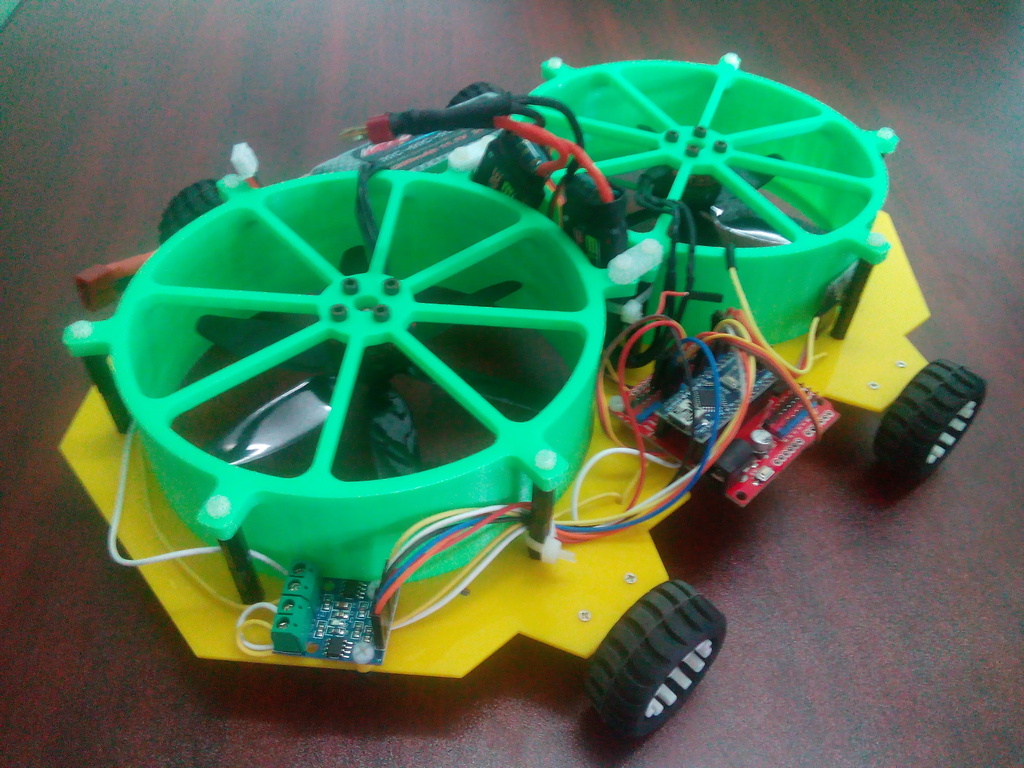
Wall Climbing Robot Frame
thingiverse
https://youtu.be/3stLtQWl3a4 In my project, six main components connect things in my wall climbing robot. A Bluetooth module is connected to an Android mobile phone, while Arduino serves as a microcontroller controlling the entire robot process. The Funduino nano board connects with the Arduino nano microcontroller. The motor driver connects with four DC motors for locomotion, and two ESC (Electronic Speed Controller) connect with two brushless motors to control speed. A long-life Lipo battery supplies power to the whole process. For control by Android phone, users must open Bluetooth on their phones and connect it with the Bluetooth module from the Bluetooth module. After connection, the Bluetooth module sends signals to the main Arduino. The Arduino nano then controls the motor driver and brushless motors. The motor driver controls four DC motors, while ESC controls two brushless motors. Components needed for building the Wall Climbing Robot include: * 2 x Brushless Motor * 2 x Electronic Speed Controller (ESC) * 2 x Brushless Motor Mount * 2 x Propeller of the Brushless Motor (5x4x6R) * 2 x Nut for Attaching the Propeller on Brushless Motor * 4 x N20 DC Gear Motor * 4 x Rubber Wheel * 4 x N20 Motor Bracket * 1 x HG7881 2-Channel Motor Driver Board * 1 x Bluetooth Module * 1 x Arduino Nano Microcontroller * 1 x Funduino Nano v3 Board * 1 x Lipo Battery (3 cells, 11.1V) * 2 x 3D Printed Brushless Holder Prototype * 1 x Robot Frame Chassis Acrylic Plate * 1 x USB Cable of Arduino Nano * Some Jumper Wires Principle of Wall Climbing Robot: This method involves installing two brushless motors on the robot chassis. Movement is achieved through the rotation of the two brushless motors, with thrust acting directly onto the wall. This method utilizes the thrust of brushless motors. In this project, I developed a wall climbing robot using the thrust of brushless motors principle and four DC gear motors. The robot platform uses two brushless motors attached to 3D printing prototype motor holders, activated by ESC. One brushless motor is clockwise, while the other is counter-clockwise. Four DC gear motors move the wall climbing robot in a vertical position on the wall. Kinematics and stability analysis of the developed robot mechanism are presented. Experiments were conducted to analyze payload capacity and safety factor for the developed robot. The brushless DC motor was used because it can provide the necessary force to push against the wall. Brushless DC motors have replaced brushed DC motors in many applications, including computer hard drives, remote-controlled airplanes, power tools, and more. In action, the direction of air flow is opposite to the direction of thrust. Thrust is a force or push, so the direction of thrust placed towards the wall generates forward thrust. The attaching principle of counter-clockwise and clockwise brushless motors improves the robot's stability and work with increased payload. Air flow of the brushless motor is reversed on the wall. A common weakness of this principle is difficulty in adhesion. About Phoewa Science: Phoewa Science offers information that facilitates creativity in Myanmar (Burma). Website: phoewa.science Facebook: facebook.com/phoewa.science
With this file you will be able to print Wall Climbing Robot Frame with your 3D printer. Click on the button and save the file on your computer to work, edit or customize your design. You can also find more 3D designs for printers on Wall Climbing Robot Frame.
